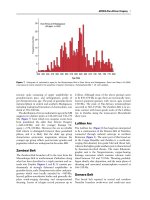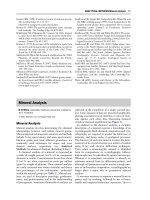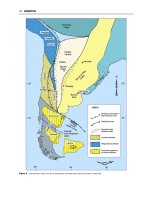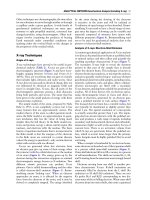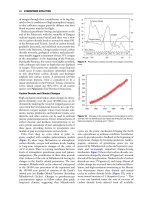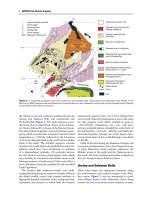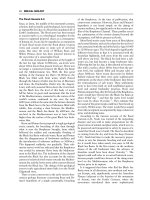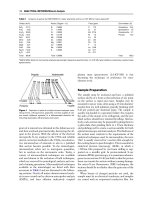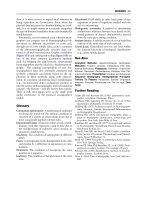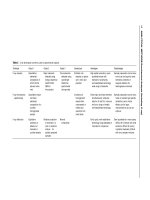Encyclopedia of geology, five volume set, volume 1 5 (encyclopedia of geology series) ( PDFDrive ) 947
Bạn đang xem bản rút gọn của tài liệu. Xem và tải ngay bản đầy đủ của tài liệu tại đây (170.51 KB, 1 trang )
312 FOSSIL INVERTEBRATES/Bryozoans
protected by a hinged flap (operculum) in some species.
Withdrawal is accomplished by the fast contraction of
a retractor muscle running between the base of the
lophophore and a point on the body wall. Different
taxonomic groups employ different mechanisms for
protruding the lophophore. However, all use a hydrostatic system entailing muscles acting on body walls to
drive coelomic fluid into the tentacle sheath, forcing
it to evert and push the lophophore out through the
aperture of the zooid.
Bryozoans have a primitive nervous system. Nervous activity can be demonstrated by touching a
lophophore, thereby inducing its immediate retraction into the zooid. The simultaneous retraction of
the lophophores of adjacent zooids shows that the
nervous systems of zooids are interconnected. Zooids
can also be linked by a system called the funiculus.
This is thought to be a homologue of the circulatory
systems found in many other animals, but it does not
carry blood or oxygen or have a heart. Instead, the
funiculus, which is linked to the stomachs of the
zooids, transports lipids and other metabolites both
within and between zooids. Movement of food resources across the colony is undoubtedly important
in the provisioning of nonfeeding zooids, developing
larvae, and newly budded zooids at the growing edges
of the colony. Pores in the skeletal walls allow both
nervous and funicular connections between zooids. In
some species soft-tissue linkages also occur over the
outer ends of the skeletal walls between the zooids.
Reproduction and Growth
The life cycles of bryozoans are complex and varied.
Colony growth occurs mostly by zooidal budding,
an asexual process involving mitotic cell division.
However, the formation of new colonies is usually a
sexual process, with meiotic cell division occurring in
the testes and ovaries, which are located alongside the
funiculus. Bryozoan colonies are hermaphroditic,
with each zooid usually producing sperm and eggs
sequentially, although some species have separate
male and female zooids. Released through tiny pores
in the tips of the tentacles, sperm are carried away in
the exhalent feeding currents and ambient flow, and a
small proportion survive to fertilize an egg in another
colony. Fertilized eggs develop into larvae. In a minority of bryozoan species the larvae are planktotrophic – they feed while in the plankton for weeks
or months. However, most bryozoan species have
non-planktotrophic larvae, which are brooded by
the parent colony before being released into the
plankton for a short period (hours or days). In both
cases, the larvae eventually settle on a firm or hard
surface (e.g. a shell or stone) and undergo metamorphosis to form the first zooid (ancestrula) of a new
colony. Budding from the ancestrula produces the
first generation of asexual zooids, which in turn bud
further zooids, and so on.
New zooids are usually budded at specific locations, such as branch tips in tree-like colonies and
the peripheral growing edge in sheet-like encrusting
colonies (Figure 2B). The location and growth orientation of new buds largely determines the shape of
the colony. Modular zooids of similar shape can be
‘assembled’ into disparate colony forms, many of
which have evolved in parallel in unrelated groups.
Various schemes have been devised to classify these
growth forms, some using geometric terms (e.g. reticulate) and others based on genera having the
growth form (e.g. reteporiform). A simple division
is into encrusting, erect, and free-living colonies.
Encrusting colonies tend to be either sheet-like
(Figure 2B), with zooids arranged multiserially, or
Figure 2 Bryozoan colony forms. (A) Encrusting runner (cyclostome Voigtopora, Cretaceous, England, scale bar 5 mm),
(B) encrusting sheet (cheilostome Porella, Plio Pleistocene, New Zealand, scale bar 2 mm), and (C) dome shaped colony (trepostome
‘Dianulites’, Ordovician, Russia, scale bar 10 mm).
